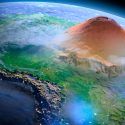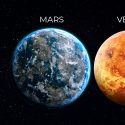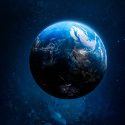Watch your head. Some seriously big asteroids are crashing into Earth. What kinds of shapes and sizes do they have? Which ones would have the deadliest impact? And which one would be most likely to hit us? Uh oh, get your bunker ready.
OK, let’s get the terminology out of the way. I say asteroids, but some of the objects on our list are not asteroids. They’re comets. Both asteroids and comets are objects in our Solar System. But they aren’t the same. Asteroids are rocky leftovers from the early formation of our planetary neighborhood. And of the over one million that we know of, most orbit the Sun in the asteroid belt between Mars and Jupiter.
On the other hand, comets are snowballs made of frozen gases, rock and dust. They orbit the Sun, and when they get too close, they start to melt. This releases a giant cloud of dust and gas that can be larger than most planets. With 3,000 known comets in the Solar System, could a few be ready to turn the Earth into a giant cloud of dust too?
CHELYABINSK METEORITE
Let’s start with a smaller object that has already hit our planet. Meet the Chelyabinsk meteorite. It exploded over Russia in February of 2013. With a diameter of about 17 m (56 ft), it was relatively small. But the impact was huge. The explosion had the energetic equivalent of 500,000 tonnes of TNT. That’s about 30 times as powerful as the bomb that was dropped on Hiroshima. It injured 1,200 people and caused enormous property damage. Pretty big effects from a little extra-terrestrial visitor.
CHICXULUB
Moving on to something bigger, we’ll go 65 million years into the past. The massive Chicxulub asteroid was likely one of the forces that resulted in the mass extinction of the dinosaurs. It was about 10 to 15 km (6 to 9 mi) wide. And its impact crater in Mexico’s Yucatan Peninsula measures 180 km (112 mi) wide and 900 m (3,000 ft) deep.
When this asteroid slammed into Earth, it devastated everything nearby. The blast wave sent enormous amounts of rocky material into the atmosphere. And it caused tsunamis as high as 1,500 m (4,921 ft). While all the soot didn’t completely block out the Sun, it reduced sunlight reaching the surface of our planet. That seriously devastated plant growth and had rippling consequences on the food chain. Eventually, it caused entire ecosystems to collapse.
OUMUAMUA
Of all the objects that could collide with us, Oumuamua has one of the more interesting shapes. This rocky, cigar-shaped object is about 400 m (1,312 ft) in length. NASA classifies it as a comet, but it exhibits traits of an asteroid too. And it doesn’t have an attachment to any star system, so we don’t know where in space it originates from.
In 2017, it passed by the Earth at a distance of 41 million km (25 million mi). So while we were safe from impact on that occasion, it could have resulted in a lot of destruction. If this interstellar guest crashed into Earth, darkness would cover our planet. And if the dust and debris stayed in our atmosphere for a long time, it would kill many plants, animals and humans that depend on the Sun.
BENNU
Bennu is not only an asteroid you should worry about. It is THE asteroid you should worry about. It has a one in 1,700 chance of colliding with Earth in September of the year 2182. At only 0.5 km (0.3 mi) wide, it’s relatively small. But remember how significant the Chelyabinsk impact was? With that in mind, you might be a little nervous when it makes a close approach to Earth every six years.
SHOEMAKER-LEVY 9
This next comet doesn’t have any chance of hitting Earth. That’s because it already collided with Jupiter in 1994. But you could imagine the destruction this 1.5 to 2 km (0.9 to 1.2 mi) comet would have caused on our home turf. It broke into 20 pieces as a result of Jupiter’s gravity. The collisions from these fragments were so powerful that they were similar to the detonations of about 300 million atomic bombs.
Plumes of debris shot as high as 2,000 to 3,000 km (1,200 to 1,900 mi). And the atmosphere heated to scorching temperatures of 30,000 to 40,000 °C (53,000 to 71,000 °F). You must be pretty relieved that Shoemaker-Levy 9 never hit us.
CERES
Last, but far from the least, is an asteroid so big it’s technically classified as a dwarf planet. Ceres is the largest object in the asteroid belt. It makes up 25% of the belt’s total mass. The radius of Ceres is 476 km (296 mi). That makes it over 60 times larger than our ancient friend Chicxulub.
If Ceres collided with Earth, there wouldn’t just be devastation. There would be no Earth. The size of Ceres alone would block out the Sun as it approached. And then, the impact would remove 10 km (6 mi) of the Earth’s crust. Hypersonic shock waves would ripple across the globe. Everything in its path would be incinerated and leveled. Nothing would stand a chance of surviving.
Our planet would essentially turn into a glowing ball of fire and melted rock. If by some miracle, or secret underground bunker, you survived, you wouldn’t last long. Soot in the atmosphere would result in something like a nuclear winter.
Sources
- “How An Asteroid Ended The Age Of The Dinosaurs”. Emily Osterloff. 2022. nhm.ac.uk.
- “About The Chicxulub Crater”. 2022. chicxulubcrater.org.
- “Assessments Of The Energy, Mass And Size Of The Chicxulub Impactor”. Durand-Manterola, Hector Javier, and Guadalupe Cordero-Tercero. 2014. arxiv.org.
- “Scientists Reveal The Full Power Of The Chelyabinsk Meteor Explosion”. 2013. theguardian.com.
- “‘Oumuamua”. 2022. solarsystem.nasa.gov.



























